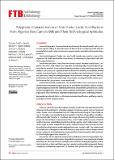Por favor, use este identificador para citar o enlazar a este item:
http://hdl.handle.net/10261/223122COMPARTIR / EXPORTAR:
 SHARE SHARE
 CORE
BASE CORE
BASE
|
|
| Visualizar otros formatos: MARC | Dublin Core | RDF | ORE | MODS | METS | DIDL | DATACITE | |

| Campo DC | Valor | Lengua/Idioma |
|---|---|---|
| dc.contributor.author | Saidi, Yasmine | es_ES |
| dc.contributor.author | Río Lagar, Beatriz del | es_ES |
| dc.contributor.author | Senouci, Djamel Eddine | es_ES |
| dc.contributor.author | Redruello, Begoña | es_ES |
| dc.contributor.author | Martínez Fernández, Beatriz | es_ES |
| dc.contributor.author | Ladero Losada, Víctor Manuel | es_ES |
| dc.contributor.author | Kihal, Mebrouk | es_ES |
| dc.contributor.author | Álvarez González, Miguel Ángel | es_ES |
| dc.date.accessioned | 2020-11-18T11:44:29Z | - |
| dc.date.available | 2020-11-18T11:44:29Z | - |
| dc.date.issued | 2020-07-31 | - |
| dc.identifier.citation | Food Technology and Biotechnology 58: 3 (2020) | es_ES |
| dc.identifier.issn | 1330-9862 | - |
| dc.identifier.uri | http://hdl.handle.net/10261/223122 | - |
| dc.description.abstract | Research background. Consumption of spontaneously fermented camel’s milk is common in Algeria, making it a feasible source of diverse lactic acid bacteria (LAB) with the potential to be used as adjunct cultures to improve quality and safety of fermented dairy products. Experimental approach. Twelve raw camel´s milk samples were used as a source of indigenous LAB, which were further characterised by examining 39 phenotypic traits with technological relevance. Results and conclusions. Thirty-five non-starter LAB (NSLAB) were isolated from 12 Algerian raw camel's milk samples and they were microbiologically, biochemically and genetically characterised. Some isolates showed proteolytic activity, acidifying capacity, the ability to use citrate, and to produce dextran and acetoin. Ethanol, acetaldehyde, methyl acetate, acetoin and acetic acid were the major volatile compounds detected. Cluster analysis performed using the unweighted group with arithmetic average (UPGMA) method, and based on the thirty-nine phenotypic characteristics investigated, reflected the microbial diversity that can be found in raw camel´s milk. Novelty and scientific contribution. The isolated strains, from a non-typical source, showed interesting technological traits to be considered as potential adjunct cultures. Cluster analysis based on the examined phenotypic characteristics proved to be a useful tool for the typification of isolates when no genetic information is available. These findings may be of use towards an industrialised production of camel's milk dairy products | es_ES |
| dc.description.sponsorship | This work was funded by the Spanish State Research Agency (AEI) and the European Regional Development Funds (FEDER) (AGL2016-78708-R, AEI/FEDER, UE), by the Plan for Science, Technology and Innovation of the Principality of Asturias 2018–2020, co-financed by FEDER (IDI/2018/000114, FICYT/FEDER, UE), and by the Spanish National Research Council (CSIC201870I091, CSIC). | es_ES |
| dc.language.iso | eng | es_ES |
| dc.publisher | University of Zagreb | es_ES |
| dc.relation | info:eu-repo/grantAgreement/MINECO/Plan Estatal de Investigación Científica y Técnica y de Innovación 2013-2016/AGL2016-78708-R | es_ES |
| dc.relation.isversionof | Publisher's version | es_ES |
| dc.rights | openAccess | es_ES |
| dc.subject | Camel’s milk | es_ES |
| dc.subject | Lactic acid bacteria | es_ES |
| dc.subject | Molecular identification | es_ES |
| dc.subject | Acidifying capacity | es_ES |
| dc.subject | Proteolytic activity | es_ES |
| dc.subject | Biogenic amines | es_ES |
| dc.title | Polyphasic characterisation of non-starter lactic acid bacteria from Algerian raw Camel's milk and their technological aptitudes | es_ES |
| dc.type | artículo | es_ES |
| dc.identifier.doi | 10.17113/ftb.58.03.20.6598 | - |
| dc.description.peerreviewed | Peer reviewed | es_ES |
| dc.relation.publisherversion | http://dx.doi.org/10.17113/ftb.58.03.20.6598 | es_ES |
| dc.identifier.e-issn | 1334-2606 | - |
| dc.rights.license | http://creativecommons.org/licenses/by-nc-sa/4.0/ | es_ES |
| dc.contributor.funder | Ministerio de Economía y Competitividad (España) | es_ES |
| dc.contributor.funder | European Commission | es_ES |
| dc.contributor.funder | Principado de Asturias | es_ES |
| dc.contributor.funder | Consejo Superior de Investigaciones Científicas (España) | es_ES |
| dc.relation.csic | Sí | es_ES |
| oprm.item.hasRevision | no ko 0 false | * |
| dc.identifier.funder | http://dx.doi.org/10.13039/501100003339 | es_ES |
| dc.identifier.funder | http://dx.doi.org/10.13039/501100000780 | es_ES |
| dc.identifier.funder | http://dx.doi.org/10.13039/501100003329 | es_ES |
| dc.identifier.funder | http://dx.doi.org/10.13039/100011941 | es_ES |
| dc.contributor.orcid | Saidi, Yasmine [0000-0001-5204-8522] | es_ES |
| dc.contributor.orcid | Río Lagar, Beatriz del [0000-0001-8107-1975] | es_ES |
| dc.contributor.orcid | Senouci, Djamel Eddine [/0000-0003-4784-7252] | es_ES |
| dc.contributor.orcid | Redruello, Begoña [0000-0003-1787-5594] | es_ES |
| dc.contributor.orcid | Martínez Fernández, Beatriz [0000-0001-7692-1963] | es_ES |
| dc.contributor.orcid | Ladero Losada, Víctor Manuel [0000-0002-7613-3745] | es_ES |
| dc.contributor.orcid | Kihal, Mebrouk [0000-0003-2901-373X] | es_ES |
| dc.contributor.orcid | Álvarez González, Miguel Ángel [0000-0001-9607-7480] | es_ES |
| dc.identifier.pmid | 33281482 | - |
| dc.type.coar | http://purl.org/coar/resource_type/c_6501 | es_ES |
| item.languageiso639-1 | en | - |
| item.fulltext | With Fulltext | - |
| item.openairecristype | http://purl.org/coar/resource_type/c_18cf | - |
| item.cerifentitytype | Publications | - |
| item.grantfulltext | open | - |
| item.openairetype | artículo | - |
| Aparece en las colecciones: | (IPLA) Artículos | |
Ficheros en este ítem:
| Fichero | Descripción | Tamaño | Formato | |
|---|---|---|---|---|
| Polyphasic_Characterisation.pdf | 751,44 kB | Adobe PDF |  Visualizar/Abrir |
CORE Recommender
PubMed Central
Citations
3
checked on 24-feb-2024
WEB OF SCIENCETM
Citations
4
checked on 25-feb-2024
Page view(s)
125
checked on 23-abr-2024
Download(s)
151
checked on 23-abr-2024

